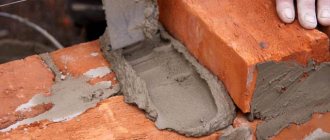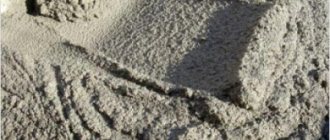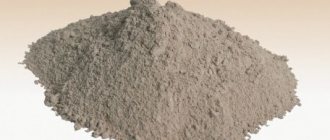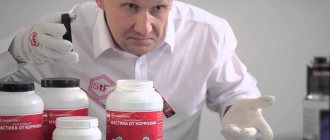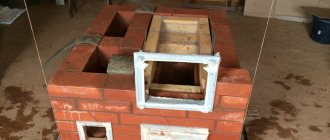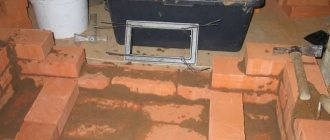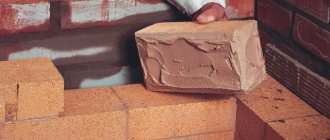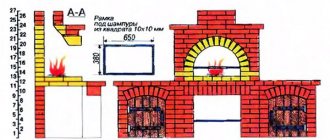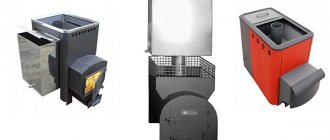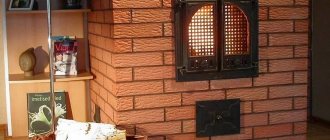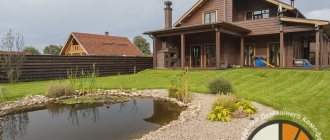When considering options for acceptable solutions for fastening bricks in fireboxes and other parts of stoves and fireplaces, it is important to understand that we are talking not only about the beauty and strength of the structure, but above all about safety.
A good refractory mixture for masonry stoves prevents the formation of cracks during repeated heating with any type of fuel, cooling, mechanical loads from cast iron grates, doors, and ash containers. Accordingly, no harmful combustion products will enter the premises, residents can enjoy the warmth with complete peace of mind and confidence in safety.
Masonry mortars for individual furnace structures
General requirements for the solution are:
- heat resistance – ensures the safety and functionality of the oven;
- elasticity is a condition for good crack resistance of furnace walls.
Based on the type of binders, all oven mixtures are divided into:
- cement;
- gypsum;
- limestone;
- mixed (if they contain more than one binder).
Furnace foundation. For its construction, lime or cement-lime mortars are used. If there is excessive moisture in the base under the foundation, cement mortar should be preferred; it is not afraid of moisture.
Chimney. For the part that protrudes above the roof, use lime or lime-gypsum mortar. If it is necessary to speed up the setting of the solution, then gypsum is added to it. If the priority is the strength of the masonry, then cement is added.
Furnace body. You can't do without clay here. The solution consists of clay, sand and water. The quality of the solution is greatly influenced by the fat content of the clay.
Which solution should I choose?
- When choosing a mortar or mixture for masonry, the heat resistance of the composition should be taken into account. For wood-burning stoves in which the heating temperature does not exceed 1000 degrees, you can choose a clay solution.
- If your stove will experience high temperatures, then you should give preference to compositions with fireclay components. It is not recommended to use cement for the construction of a firebox. Even in a wood-burning stove with an average combustion temperature, it will begin to crack and fall out.
- Cement mortar is ideal for laying the top of the chimney and the base of the heating device. It is resistant to precipitation and wind loads, which is very important for these parts of the stove.
You can prepare a high-quality building mixture for laying bricks for stoves yourself. This process will take some time. It requires basic materials: clay, sand, cement, lime and water.
Mixing and quality control
First, clay is poured into the trough. It should be filled with water in a small volume. The clay is left for a period of six hours to two days to soak it. During this time it is stirred. For example, you can put on rubber shoes and trample the clay. Water should be taken 1/4 of the available volume of raw materials. Next, sifted sand is added. The entire mixture is mixed with a shovel. You can check the consistency by the behavior of the mass. If the solution slides off the shovel slowly, then mixing can be completed. To determine plasticity, you should mold a small flagellum 20 cm long and 1.5 cm thick. It should be connected around a five-centimeter wooden blank. The flagellum should stretch evenly. If it is torn, then the ends should be sharp. If there are no cracks on the bend, then the solution is too greasy. Accordingly, in the presence of numerous breaks, the mass is “lean”. In the second case, clay should be added, and in the first, sand. As a result, you need to get several small cracks on the bend.
Selection and preparation of sand
The simplest solution includes clay and sand. The best sand is traditionally considered to be mountain sand - it has a rough surface texture, thanks to which the solution significantly enhances the quality of the connection of masonry bricks. Sea and river sand turns out to be not so good against the backdrop of mountain sand - water polishes the surface of the grains of sand, as a result of which they lose their adhesive properties.
Immediately before creating the solution, it is recommended to sift the sand through a sieve with 1.5 mm cells. If, even after sifting, impurities remain visible in the sand, it must be washed with water. Sand for washing is scattered on a stretched burlap, and a stream of water is directed at it. You can finish washing only after the water becomes clear after passing through the sand.
The main options for mixtures for laying a fireplace
It is necessary to understand that the construction process involves three main stages:
- foundation preparation:
- masonry of the main mass;
- external finishing.
The corresponding stage will require a different mixture, although universal options can be used.
To fill the foundation, you need a concrete solution: take three parts sand to one part cement and dilute it with water until it looks like wet soil. You can add fine crushed stone.
This solution is not sold ready-made; it must be prepared immediately before pouring the base. The setting of the solution will begin in half an hour, and final hardening after a day. Next, you can proceed directly to laying brick or stone.
This process requires a fire-resistant masonry mixture, which will contain fireclay - a special type of heat-resistant clay. You can buy it ready-made and dilute it with water to the desired consistency, or you can make it yourself, which will save money, but will require more time and responsibility.
Preparation of mortar for plastering can be done using lime. This option is quite widespread. Components:
- lime;
- water;
- gypsum or cement.
The lime must be carefully sifted so that there are no stones or large compactions, since such inclusions will not be able to completely dissolve, and when dry they will “shoot”, which will negatively affect the final result.
Cement or gypsum are added to make the plaster more durable, but you can do without them. First, mix the dry ingredients, then add water in small portions. The lime will begin to slake as it dissolves.
The consistency should be like thick sour cream; if you get a liquid solution, you should add a dry component. During the cooking process, it is necessary to thoroughly mix the ingredients so that the hardening process does not begin. Once ready, you can start plastering.
conclusions
A high-quality stove device requires masonry with several types of mortars. You can buy them at a specialty store or make them yourself. Depending on what type of solution you want to make, you need different components.
To lay a high-quality device that will last for many years, you need at least three solutions. One is clay, for laying the main part, a mortar of clay and fireclay sand for the firebox, and cement or cement for the base and outer part of the chimney.
Rules for preparing and applying ready-made mixtures
The advantage of purchased formulations is the ease of mixing the solution. To be able to prepare it, you will need a container of the appropriate volume and, without fail, a mixer or an electric drill with an attachment. The fact is that manually preparing a solution requires a certain amount of physical effort, and to make the work easier, more water is often added to it than it should be. As a result, there is a loss of quality of the finished mixture.
Preparation of the solution consists of pouring the dry mixture into warm water and stirring the mass until the lumps are completely dissolved. The consistency should be similar to thick sour cream. The solution is left for an hour, after which it is thoroughly mixed again.
Dry mixtures for laying fireplaces and stoves have water-retaining ability, so the bricks do not need to be pre-wetted. Firstly, it saves time, and secondly, it significantly reduces the period required to dry the masonry. The good elasticity of the solution, obtained through plasticizing additives, is reflected in the ability to make thin seams (2-4mm) and, as a result:
- on economical consumption of bulk material;
- on the attractive appearance of stove and fireplace walls;
- in the absence of cracks, which often appear in a thick masonry layer.
Heat-resistant compounds should be worked at an ambient temperature of no lower than +10 and no higher than +35 degrees. The solution can be applied in a layer of 10-12mm. Interestingly, seams made of fireclay clay mixture during the operation of the furnace acquire additional strength under the influence of heat.
Preparation of composition for laying fireclay bricks
A fireproof masonry mixture prepared on the basis of fireclay tolerates fairly high temperatures. Here you can use coal without any problems when heating, without worrying about the masonry. The preparation should be taken most carefully and responsibly, since if the components are calculated incorrectly or the manufacturing sequence is violated, the result may not be a completely suitable mixture for installation.
- We put the fireclay clay in a bucket and fill it with water so that it is not visible and leave it to infuse for about 12-72 hours. You will need to stir the soaked mixture from time to time.
- Then this clay will need to be rubbed through a sieve. It is best when the cell does not exceed 3x3 mm. Using the same sieve, you need to pass the sand and add it to the clay. Many experts consider the best ratio for masonry: 2 parts sand to 1 part clay. The dry composition of clay and sand must be mixed until smooth, and after that add water.
Attention: In order for the masonry composition to come out as good as possible, it must be constantly stirred when adding water. In this case, water should be added continuously, but in a small stream.
When the mixture becomes creamy, stop adding water. It is at this step that it is best to add salt to the solution.
- A regular bucket of mixture requires about 150 grams of salt. Salt gives the solution better strength. Then add about half a trowel of cement - it will strengthen the composition. In some cases, mixing with liquid glass occurs.
- A correctly prepared solution will flow down the shovel in an even layer, while an incorrect one will spread strongly or even become a lump. This mixture is the optimal choice for filling voids.
- The approximate amount of mortar for laying one hundred bricks is two buckets. In the case of laying out a Russian stove, the quantity must be increased by about twenty percent due to the specifics of the masonry.
A fireproof mixture is used for the fireplace and stove. By the way, the smaller the fraction of components, the higher quality the composition will be.
Manufacturers of ready-made furnace solutions
Fire-resistant Plitonit masonry mortar
Russian consumers can purchase compositions of domestic and foreign production. Heat-resistant, fire-resistant and standard masonry materials are available on the market.
Plitonit
A domestic brand that produces stove solutions using German technologies. Popular products include:
- Thermal laying. An economical product for repairing and laying the outer parts of fireplaces and stoves;
- Fireproof. A mixture with reinforcing components is used for the construction of a combustion chamber made of heat-resistant bricks;
- Hot melt adhesive. The adhesive material on which ceramic tiles sit. The glue is also used as plaster.
Mixing proportions are indicated in the instructions and depend on the type of composition.
Stove maker
Fireproof mixture for masonry stove is made on the basis of clay and cement ingredients. It has high water repellency and ensures adhesion strength. The peculiarity of the Stove stove masonry mixture is that the heat-resistant products can withstand heating up to +1350 degrees. The advantages of the material include heat resistance, ease of use and reliability of the seam. The disadvantages are high consumption due to rapid setting.
Bossnab
Terracotta is a dry mortar based on fireclay clay.
Russian products based on red clay and quartz sand allow you to mask the seam. The mixtures are available in two series:
- Budget. Inexpensive compositions in the form of a mix of red clay and sand. The materials are suitable for interior work and are low in consumption - 25 kg is enough for 90 bricks;
- Premium Characterized by resistance to temperature fluctuations. Plasticizers and lignosulfates in the composition allow masonry to be carried out outdoors.
Budget solutions have a heat resistance of +500 degrees, premium ones – +1100 degrees.
Terracotta
Heat-resistant products are made from kaolin clay, fireclay and sand, and are environmentally friendly. The plastic solution allows you to form a strong seam that can withstand heating up to 1300 degrees. The masonry line is uniform, the composition is applied easily. The manufacturer recommends sifting the material to remove large grains of sand and working with soaked brick.
When building a stove yourself, you need to choose the right materials. Ready-made factory mixtures eliminate the time spent on preparing the solution and preparing the ingredients.
Fireproof putties
In addition to traditional refractory mortars, putty materials are also used in finishing work. They are used for lining heated surfaces. Almost all materials for such work have a similar composition, only the proportions of the components differ. The basis everywhere is clay and lime.
Most often, fireproof putties are used to finish the stove for further finishing. The mass has the following advantages:
- Safety. The composition of the substance is environmentally friendly. When heated, the putty does not release components harmful to humans.
- Fire resistance. Even with strong heating, the formation of cracks on the surface of the putty layer is unlikely.
- The service life of the coating (if properly applied) is more than 40 years.
- High degree of adhesion with other building materials and coatings.
When finishing the stove, it is important to follow the correct sequence of application of materials. Otherwise, the finish of the product may crack.
Options for mortars for laying stoves
Today, various modifications of masonry mortars are used, among them the following are popular:
- heat-resistant mixture, which is intended for outdoor use. Such solutions are used for masonry and plastering of barbecues, barbecues, smokehouses, stoves, which are used only in the open air;
- mortar for laying household, industrial stoves, fireplaces made of fireclay refractory bricks. The operating temperature of such structures can be up to 1750 degrees;
- a special masonry mixture designed for working with red brick. Using this solution, fireplaces are laid. household stoves, heater stoves, the operating temperature for which is up to 850 degrees;
- A special masonry mixture is used for fastening tiles and plastering the surface of fireplaces, chimneys and stoves.
The masonry mortar has the following characteristics:
You need to add lime paste to a thin solution, and sand to a fat solution.
- the appearance must be uniform and free from foreign impurities;
- moisture content of the composition - no more than half a percent;
- maximum grain size - up to 2.5 mm;
- bulk density - 1500 kg per cubic m;
- ready-made masonry mortar can be used for three hours;
- the water-holding capacity of the resulting solution is 95 percent;
- compressive strength - two Mega Pascals;
- loss of mixture mass during calcination - up to 5 percent.
The special composition that is used for filling and repairing the hearth inside the furnace has the following characteristics:
- the minimum temperature for work is five degrees Celsius;
- time to use the ready-made solution is one hour;
- maximum grain size - 5 mm;
- water consumption for preparing 25 kg of mixture is 2.5-3.5 liters, finished mass is 11-12 liters per 25 kg;
- heat resistance - 1300 degrees.
Features of application
If you prepare the solution yourself, you must consider several rules:
- To build a furnace array, it is worth increasing the heat resistance of the material.
- With a joint thickness of 3 mm, 25 kg of mortar is needed for every 90 bricks.
- Fatty types of clay lose strength after drying and crack.
- In order to increase the strength of medium-fat clay, cement can be added to the mass.
- You can speed up the drying of the masonry by adding lime to the solution.
- The volume of building materials is checked after the final batch.
- For each day of work, a new portion of the mixture is prepared.
The stove should be heated after laying after 3 days.
When working with ready-made products, follow the manufacturer’s recommendations. The materials are accompanied by instructions with specific tips for use:
- Water is added to the contents of the bag.
- The ingredients are mixed with a drill with a mixer attachment for 1 hour of use.
- After hardening, they do not work with the mixture again.
- The heating structure is laid at a temperature of +10 degrees.
- To prevent cracking of the seam, it is necessary to purchase materials with plasticizers.
- The first heating is not carried out for 3 days after laying.
- Cladding is carried out 20-30 days after putting the furnace into operation.
- Efflorescence on the seam is removed with a damp cloth.
The effectiveness of ready-made solutions is better than homemade ones, but they are more expensive. For this reason, it is worth researching the products of different brands.
Factory-made masonry mixtures for laying stoves
We are talking about fireproof dry powders, which, after dissolving in water, turn into a homogeneous mass. The cooking recipe is usually indicated in the accompanying instructions. Along with the usual components (sand and cement), the solution contains special heat-resistant additives.
The refractory mixture for laying furnaces produced at the enterprise has a number of advantages:
- Well-calibrated composition. Under production conditions, careful dosage of each component is carried out, according to time-tested recipes and proportions.
- Specific additives. The components that give refractory mixtures their “proprietary” characteristics are often not commercially available (and sometimes even kept secret).
- Versatility. As a rule, industrial solutions are multifunctional: they can be used to lay stoves and then plaster finished walls.
- External aesthetics. Although a finishing finish is still applied over masonry or plaster, it is much more pleasant to work with an attractive-looking mortar.
Our stove makers especially liked the products of such manufacturers of masonry mixtures for stoves and fireplaces: “PLITONIT”, “TERRACOT”, “Makarov Stove House”, “Pechnik”, “Scanex”, “SPO”. As for the disadvantages of this type of material, it is usually called their high cost. In cases where it is necessary to save money, they try to use self-prepared heat-resistant solutions.
Working with mixture and fireclay bricks
Mixtures for laying fireproof stoves must be made with high quality
But it is equally important to do their proper installation.
Particular attention must be paid when filling the seams with mortar. If the filling is poor, water may get into the seams, and if it freezes, the masonry will crumble much earlier than planned.
The choice of brick laying category depends directly on the future temperature condition. The higher the temperature, the smaller the seam should be:
- 1 mm – first category;
- 2 mm – second category;
- 3 mm – third category;
- more than 3 mm – fourth category.
To determine the quality of the seam, I use a special probe with a width of 15 mm, and the thickness must be equal to the seam.
- The probe must penetrate 20 mm into the seam. To ensure that the bricks are positioned correctly, they are tapped with the handle of a trowel. To ensure that the seams are of a certain horizontalness, ordering slats are used and a cord is attached to them. After the first layer, the laying is determined only by this cord.
- The characteristics and reliability of masonry largely depend on the uniform application of the mortar to the surface.
Note: The brick sucks moisture out of the mixture, preventing it from drying out. Therefore, the brick is periodically wetted during the laying process, or even pre-soaked beforehand.
The fireproof mixture will help you make a quality structure, but you should never rush. You should look at photos and videos to understand the entire cooking process. After all, construction requires high-quality materials.
This is interesting: How to choose a set of drills: we explain the question
Advantages and disadvantages
You can quickly prepare a high-quality solution from a purchased mixture.
For laying stoves and fireplaces, a high-temperature mixture is used, which contains clay, sand, lime or cement, and heat-resistant ingredients. To obtain a homogeneous mass, water must be added to the material. Using finished products has several advantages:
- ease of mixing components;
- ready-made recipe that ensures the strength of the composition;
- versatility of use - suitable for cladding, laying external and internal parts;
- attractiveness and evenness of the masonry seam;
- availability of complete instructions with operating and mixing rules;
- ease of application and no risk of seam destruction.
The use of building materials is associated with some difficulties. The mass is mixed only with a mixer or in a concrete mixer, it hardens quickly, so it is prepared in portions.
Mortar mixtures
One of the most popular mixtures for stoves is mortar. It comes in the form of a very fine powder. For use, the powder is diluted with water and used for masonry in tandem with refractory bricks or stone.
Not every mortar mixture is suitable for laying a hearth. There are fire-resistant and conventional hardening mixtures. The latter become hard during heat treatment, like ceramics. They contain hydraulic cement.
Mixtures without hydraulic inclusions with other additives are called fire-resistant. There are different types of mortar, differing in grain size. So, fine-grained mixtures are called mixtures with particles up to 1 mm, and large-grained - up to 2.
Different markings of the solution are designated by the letter abbreviations MS. The material is most often used for home or commercial stoves; for industrial fireplaces, an alax mixture is used. The finished shell from the mortar mixture has very high strength and can be used for many years without problems.
Process of making cement mortar
When laying the outer part of the chimney, which is exposed to various precipitation and wind, a strong mixture is needed to secure the bricks. In this case, it is worth using cement mortar. But it is impossible to completely lay the stove on a cement mixture: sudden changes in temperature will lead to deformation of the seams and damage to the structure.
Preparation method
To work you will need:
- Portland cement;
- crushed stone;
- fine, sifted sand;
- sand that has fireproof characteristics is fireclay.
A simple recipe: All ingredients should be mixed in a ratio of 1:2:2:0.5. Add water and mix thoroughly.
There are other proportions when using the M400 cement grade (cement, sand, crushed stone):
Storage time and application features
The mixture can be used after one hour has passed from the moment of mixing. It is better to use the finished solution within several hours. Then it tends to dry out.
To protect against drying out, you can water the mixture with odea. But constantly adding water can reduce quality characteristics. Therefore, it is better to prepare small batches of the solution and use them as quickly as possible.
Features of preparing working solutions
Regardless of the chosen composition of the refractory mixture, the master will need water in any case.
It should not contain large amounts of hardness salts - calcium and magnesium bicarbonates. Usually, the population knows the characteristics of local water, the location of sources with water of low hardness. If necessary, you can slightly soften the water using special methods, but it is advisable to do this only as a last resort, since the pleasure will be quite expensive.
For do-it-yourself masonry of all parts of the furnace, white sand with a quartz composition is ideal. Yellowish sand grains can be used for laying any parts of the stove structure, except for the combustion chamber.
There are long-standing historical methods for determining the amount of sand to add to clay. The ancestors lived a leisurely, measured life, so the mixtures were tested for more than 3 weeks. Now people do the test faster - they prepare several versions of cakes or balls, wait for them to dry completely, then drop them onto a wooden surface from a height of one meter. The composition that did not split is worthy of attention. If there are several such resistant samples, the height for testing can be increased, ultimately choosing the most durable option.
The final control check can be carried out as follows: smear the wide part of the brick (bed) with the prepared mixture with a layer of mortar of at least 3 mm, lay the second brick on top, press it well by tapping it with a wooden handle, wait 10 minutes and lift it. If the bottom brick is held and does not fall, the compound is suitable.
DIY clay mortar
This type of solution is the most famous. It has been used since ancient times and was accessible to everyone. A mixture of clay and sand accumulates heat from the stove and transfers it to the room.
Kinds
Masters have a classification of clay solutions according to their fat content:
- Skinny - solutions made from clay, which are characterized by low plasticity due to the low percentage of fat content. When dry, they become thin and brittle. A stove structure made using such a solution will not last long, because all the seams crumble after drying.
- Normal - characterized by good plasticity. They are strong and durable. They are the most suitable option for stove masonry.
- Fatty – solutions in which the percentage of clay fat content is quite high. Although they are plastic, after drying there is a high probability of cracking.
4 different cooking methods
The most well-known methods for preparing clay mortar are:
- First. The required amount of clay is soaked in water 24 hours before laying. The solution is filtered and sand is added. The resulting mixture is mixed well. If puddles of liquid clay are visible, you need to add more sand until a uniform consistency is obtained.
- Second. It is necessary to mix clay, which has heat-resistant characteristics, with fireclay sand. Ingredient ratio: one to one. You need to add as much water as the consistency of thick sour cream requires.
- Third. This method requires loam. It is important to mix several solutions and choose the most suitable one. The ratios of clay, sand and cement: ten and one to one, then nine to two and one, ten to one and one, one to 0.1 and one. Pour the mixture into boxes and wait until completely dry. The most even and dense option is well suited for the construction of a furnace. Clay mortar prepared using the third method can be used for laying elements that will not heat up more than 600 degrees. When temperatures are higher, it becomes deformed. Therefore, its use is limited to the external laying of furnace elements.
- The fourth method is with various additives. Clay and sand must be thoroughly reseeded. Mix the resulting mixture with water. Mix the solution until it has a creamy consistency. Salt is added to the sand-clay mixture, maintaining a ratio of one to ten. You can add the same amount of cement. They can be dissolved first, and only then added to the general solution. Additives will provide the masonry with strength and resistance to temperature and pressure.
Checking the quality of the solution
You can determine the required quality of clay mortar in the following ways:
- "Ball". You need to take 4 parts of clay. Add sand to the first in a ratio of 4:1, then 2 to 1, 1 to 1, 1 to 1.5, where the first indicator is the amount of clay, the second is the amount of sand. All mixtures are mixed to the same thick consistency. When the clay has reached the required homogeneity, balls are rolled from it. These balls need to be flattened with your palms. The resulting cakes are flattened onto the surface to dry. After some time, the quality of each mixture can be determined.
When the material is completely dry, you need to determine the most suitable mixture for laying. You should pay attention to the following characteristics: cracking when drying, cracking under pressure, falling. The part that passed all the tests and did not deform has the most successful proportions. Choose these proportions and the bricks in the stove masonry will be fixed as firmly as possible, the seams will not dry out or spill out.
- "Flagellum". A piece of solution is crumpled and rolled into a roller. The ends of the part are stretched. If it stretches evenly, then it is made of fatty clay. If it becomes thinner and gradually breaks, the clay is normal. When the ends of the roller break unevenly, the clay is thin.
- "Paddle". To determine the highest quality material, you need a bowl in which the solution is prepared. It must be mixed with a spatula. If a layer of 0.1 cm remains on its surface, additional clay is required. If it reaches 0.2 cm and clots form, this is the most optimal option. When clay sticks more than 3 mm, it shows greater fat content. The mixture requires the addition of sand.
Where can I get free clay and sand?
You don't have to spend money on buying clay. You can find it yourself on your site. But to do this, you will have to dig a hole 5 m high, and only then start searching. The best places to look for clay are river banks and ravines.
If you find a clay-like rock, take some of the material and roll it in your hand. If, after intensive manipulation, you manage to roll out a flexible roller that does not break, you have found the right place.
If the material is not sticky, but simply crumbles, you need to continue your search. Clay rocks may differ in color. The most suitable for construction is kaolin - white clay. But other types (brown, red, gray) are also good for stove bricklaying. The extracted material requires purification from various impurities and other particles.
Sand can be obtained from quarries, ravines and shallows. Depth of occurrence - 1-2 m from the ground. After mining, it is necessary to wash, dry and sift the sandy material.
How to calculate the quantity correctly?
It must be remembered that the larger the brick, the less mortar will be required for its laying. And vice versa. The amount of mortar depends on the nature of the pores: the denser the brick, the less mortar is required. Consumption depends on the thickness of the seams: the thicker it is, the more material is needed.
For every square meter you need 0.25 cubic meters. m of solution. To calculate the required amount of mortar for the entire stove structure, you need to calculate how many square meters the stove has in length and width. With a building thickness of 1 brick, approximately 75 liters of mixture are required.
Multiplying 75 by the area will give you the required amount of mortar for the entire job. But it should be taken into account that such indicators are approximate. You can prepare the solution in parts, so it will be more convenient to determine the required amount of consumables and not make more or less mistakes.
Usage
There are no specific recommendations. A clay mixture that is left for a couple of days will dry out. But it can be soaked. The newly soaked solution is no worse in its characteristics than the freshly prepared one.
Clay does not tolerate moisture. Therefore, do not wet the bricks when using clay mortar. It is also worth protecting the masonry from further exposure to moisture.
Lime mixture
It contains lime paste and sand.
You can prepare lime paste yourself by mixing quicklime and water in a ratio of 1:3. But it is better to buy ready-made dough in the store, its quality is much higher. To prepare the mixture, fine sand, sifted through a sieve, is mixed with lime dough in a ratio of 3:1 and diluted with water until a creamy consistency is achieved. After preparing the mixture, you need to check its plasticity. This is done by stirring the mixture with a wooden bar:
- lean mixture - does not stick to the plank at all, you need to add lime to it;
- normal - after removing the plank from the solution, it remains on it in the form of a film or lumps;
- greasy - sticks to the wood in a thick layer, you need to add sand.
The disadvantages of the lime mixture are the long drying time of the masonry and the negative effect on the respiratory system.
Plaster for stoves and fireplaces
There are several standard plaster compositions that are used to coat furnace equipment:
- Lime mixture . This composition is created from clay dough, lime and asbestos. The proportion is very simple - two parts sand, one part lime and a tenth part asbestos.
- Cement mixture . Clay and cement for a fireplace in this composition have the same volume. You need to take two parts of sand, and add a tithe of asbestos to all this.
- Fiberglass mixture . The composition of such a mixture is one part clay, two parts sand, one tenth fiberglass.
Heat-resistant mixture for masonry stoves
To give greater strength, concrete is also added to the material. In terms of its performance properties, such a solution will not be inferior to lime. Hardening of the concrete mass begins after 45 minutes. Before mixing the components, they are passed through a sieve. Then sand is poured into the prepared container, and cement is poured on top of it. This mass is mixed until a homogeneous composition is obtained. Then water is added. When mixing, it is necessary to achieve a viscous consistency. The solution should not be too thin or thick. To construct a monolithic firebox, components are used in the following ratio:
- 1 part Portland cement (M400);
- sand – 2 parts;
- brick crushed stone - 2 parts;
- fireclay sand - 0.3 parts.
Optimal fat content of clay
To check the fat content of this main component of the masonry mortar, there is an elementary way. You need to take 0.5 liters of clay and mix it with water until the consistency becomes like stiff dough. Then the resulting mass must be thoroughly kneaded and formed into a ball with a diameter of 4–5 cm. When it dries, it must be placed between two planks and squeezed.
If as a result the ball cracks when squeezed halfway, its fat content is high, which means the mixture does not have enough sand. If it disintegrates almost immediately, you need to add clay. In the event that cracks appear when the ball is compressed by a third, the composition of the oven mixture is selected ideally.
To ensure the reliability of the future furnace, the clay solution for laying it must be prepared from thoroughly cleaned components and have normal or high fat content.
The obvious advantage of the solution, the ingredients of which are carefully selected and dosed, is that the masonry will have a neat appearance due to the thin seam. In addition, a stove mixture of normal fat content will provide the structure with sufficient reliability and durability. True, such a solution still has one drawback: such a solution is not resistant to environmental humidity.
